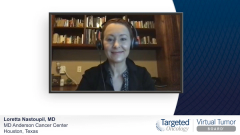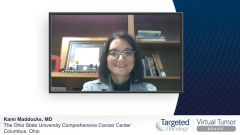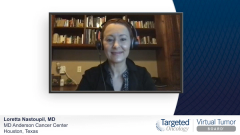
Case 2: R-CHOP Refractory DLBCL, Transplant Ineligible
Ian Flinn, MD, MPH: The second case is a 78-year-old man who presented with fever, a 7-lb unintentional weight loss and occasional chest pain. His past medical history is significant for diabetes, which is medically controlled. A physical examination he was tired appearing. He would have had palpable bilateral cervical lymphadenopathy. On laboratory examination he was anemic with a hemoglobin of 10.8. His creatinine was elevated at 1.7, and he had an elevated LDH [lactate dehydrogenase] of 300. All other of his labs was within normal limits.
A lymph node biopsy revealed a CD 10-positive, CD 20-positive diffused large B-cell lymphoma. His FISH [fluorescence in situ hybridization] testing was negative for rearrangements of BCL6, BCL2, and C-MYC. On imaging a whole-body PET [positron emission tomography] scan showed activity in multiple lymph nodes above and below the diaphragm. And the largest lymph node was 3.9 cm.
He also had evidence of subcutaneous tissue involvement. An MRI of the brain showed no evidence of lesions. And he had stage IV disease with an ECOG performance status of 1.
His treatment was initiated with R-CHOP [rituximab, cyclophosphamide, doxorubicin hydrochloride (Hydroxydaunomycin), vincristine sulfate (Oncovin), prednisone] and he tolerated it well. But an interim PET scan after 4 cycles unfortunately showed progressive disease.
Kami Maddocks, MD:Here we have an advanced stage aggressive B-cell lymphoma. The patient may be a little bit older, has some underlying comorbidities, diabetes, although well controlled. Goes on to get standard therapy with R-CHOP. And then on receiving PET shows progression of disease.
Are you guys using interim staging in diffused large B-Cell lymphoma? And if so, when are your using it—after 2 cycles, after 4 cycles—don’t do PET?
Ian Flinn, MD, MPH: I tend to do it after 2 or 3 cycles. I generally use a CT scan. If someone has obvious nodes that I can feel and know that the person’s responding, then I might delay it to the third cycle and just do a CT scan at that point. But if I have nothing to follow, then I generally do it after 2 cycles.
I’d like to hear what other people have to say. I don’t often do PET scanning in patients with large-cell [disease] and my experience in Hodgkin disease, mostly because I’m not sure I know what to do with the data. In this case the person had progressive disease but they probably could have seen that from the CT scan. And patients who don’t become PET-negative after 2 or 3 cycles of R-CHOP, there’s a lot of controversy about what the best course of action for that patient is. Clearly it’s not a good prognostic factor, but how to act upon it is less clear to me.
Jason Westin, MD, MS, FACP: I agree that it’s controversial and there’s not a right or wrong answer here. For patients that don’t have palpable lymph nodes, if I can’t tell what they’re doing I’ll get a PET CT scan either after two or three cycles. There’s not a consensus of what to do. If it’s not a CR [complete response] I agree with Dr Flinn that we have troubles with false-positive PET Scans, the residual abnormality, which is improved but not resolved. It does help to give confidence that the therapy is working if someone does have a CR on interim PET. Lack of a CR [complete response] is concerning but it wouldn’t be something I would necessarily change treatment off protocol.
We do have a clinical trial that is allowing patients with certain high-risk features who do not achieve a good response on an interim PET to go on to receive CAR [chimeric antigen receptor] T cells. There’s ZUMA-12 trial [NCT03761056].
The ZUMA-12 Trial enrolls patients after 2 cycles of frontline chemotherapy without a good response if they’ve got high-risk disease such as this patient coming in. But off the trial there’s not really a right or wrong approach, and it’s more of if you’re not sure if the patient is responding or if you’re concerned that they’re progressing early, getting that scan to confirm and not waste any more daylight of getting toxic and effective frontline therapy.
Loretta Nastoupil, MD:The only thing I’ll add is that for our double-hit patients, sometimes having an early glimpse that they’re likely to fail may help you line up that next course of treatment. Because in my opinion most patients do quite well with frontline R-CHOP. But those that don’t, you have a narrow window intervening before they succumb to their disease. Those are the patients that I generally will get a PET after 2 cycles and may act on. Outside of that, I 100% agree with all the comments that have been shared about the challenges of interpreting those interim scans in large-scale lymphoma.
Kami Maddocks, MD: I use the same approach. I typically do them. It’s reassuring if somebody’s in a complete remission. It’s obvious if they’re progressing that you need to do something else but it’s challenging when they’re responding but there’s still disease. You think they probably are not going to do well but there’s no real great change or great option at that point.
Transcript edited for clarity.














































